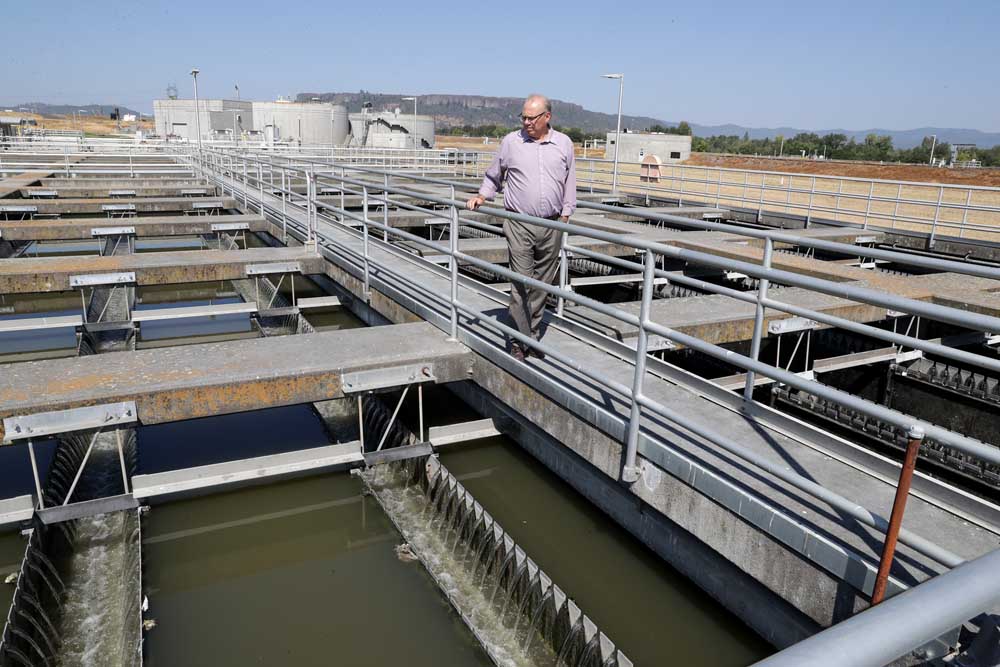Millions more? Medford’s wastewater plant upgrades face soaring interest rates
Published 4:30 pm Thursday, February 29, 2024

- Medford Public Works Director John Vial walks through the Medford wastewater treatment plant Tuesday off Kirtland Road next to the Rogue River.
An up-to-$300 million overhaul of the city of Medford’s Regional Water Reclamation Facility has hit headwinds because of higher interest rates.
The massive upgrade of the wastewater plant, which is located on Kirtland Road in Central Point and serves most cities in the valley, is needed to avoid violating the federal Clean Water Act, which could result in fines or other penalties.
Medford officials, in figuring out how to pay for the overhaul, have confronted interest rates on loans that have gone from a low of 1.8% just a few years ago to as much as 5% in the current market. Higher interest could add millions of dollars over the life of the loans.
“Our hope, number one, is that interest rates go lower,” said Ryan Martin, Medford’s chief financial officer and assistant city manager.
Lower interest rates would mean ratepayers in the valley wouldn’t get hit with even steeper increases to help pay off the loans.
The current sewer treatment bill for all users of the Regional Water Reclamation Facility is $9.79 per month. This is expected to rise to $35-45 per month over the course of the next 10 years.
The first annual increase of the monthly fee is estimated to be around $2. This increase is expected to start August 2024.
“Our hope is that interest rates will decline substantially over the next two years when we need to borrow the bulk of the money, and all the savings will be passed onto the ratepayers,” Martin said.
The city needs to upgrade up to 60% of the existing wastewater plant next to the Rogue River.
This will reduce nitrogen and phosphorous levels by about 70% and also reduce the temperature of the treated water before it goes into the river.
The permit for the treatment plant is in the city’s name, and city officials have attempted to explain to various cities in the valley the need for the upgrades, which also will pave the way for population growth, as well.
If the city doesn’t follow through with the improvements, city councilors could be held personally liable, and the state could place a building moratorium on the region if it ignored the regulations. The city could also face criminal penalties. City councilors have generally voiced support for the plant overhaul in the past.
Martin said the city will borrow $20 million of the $300 million this year at an interest rate of 4.5% to 5%. The loan will be for 10 years, after which it can be refinanced.
The $20 million is needed to pay for the design, engineering and environmental analysis of the project.
Once those are completed in two years, the project will go out for bid, and the city will have the actual costs for the expensive and complicated overhaul of the plant.
“There are a lot of unknowns with this project,” said Kristina Wilson, the city’s communications and marketing manager.
Another loan could come from the federal Environmental Protection Agency, which has a grant available for Clean Water Act projects that could provide financing for up to 49% of the plant upgrades.
Even the EPA Water Infrastructure Finance and Innovation Act has interest rates of around 4.5%, but the loan can be refinanced if rates go lower.
Martin said the goal is to find ways to keep rates as low as possible and not lock the city into long term loans of, say, 20 or 30 years. Short-term loans can be refinanced, with the hope that rates drop significantly in the meantime.
Upgrades to the plant were required after the city faced legal challenges and initially balked at the expensive and difficult option of removing the phosphorous and nitrogen.
In 2018, Northwest Environmental Advocates sued Medford, claiming the pollutants discharged into the river violated the Clean Water Act.
The city received an Oregon Department of Environmental Quality permit to discharge the treated wastewater into the Rogue River in 2021 with the understanding that the city would develop a plan to address the pollutant issues.
“We appealed that permit — formally appealed that permit — that it would be too costly, and it went all the way to an administrative law judge who ruled against the city,” said John Vial, the city’s public works director.
Northwest Environmental Advocates also appealed the permit. “They thought it wasn’t strict enough,” Vial said. But the judge ruled the permit was sufficient to address the discharge issue, he said.
About 18 million gallons are processed daily at the Regional Water Reclamation Facility, but during rainy months that amount can rise to 70 million gallons.
The facility originally served Camp White, a U.S. Army training base, but the city took it over in 1948. Full reconstruction occurred in 1970.
The main way the sewage is treated is through microorganisms that eat the waste materials. Membranes and other methods further clean up the wastewater.
Before it’s sent into the Rogue, a strong dose of chlorine is added to the highly treated wastewater, then another chemical removes the chlorine.
The population served by the wastewater plant is about 160,000 today but is expected to grow to 212,250 by 2045, and much of that growth is expected in Medford.
This story has been updated to clarify the amount of the rate increases for sewer customers.






